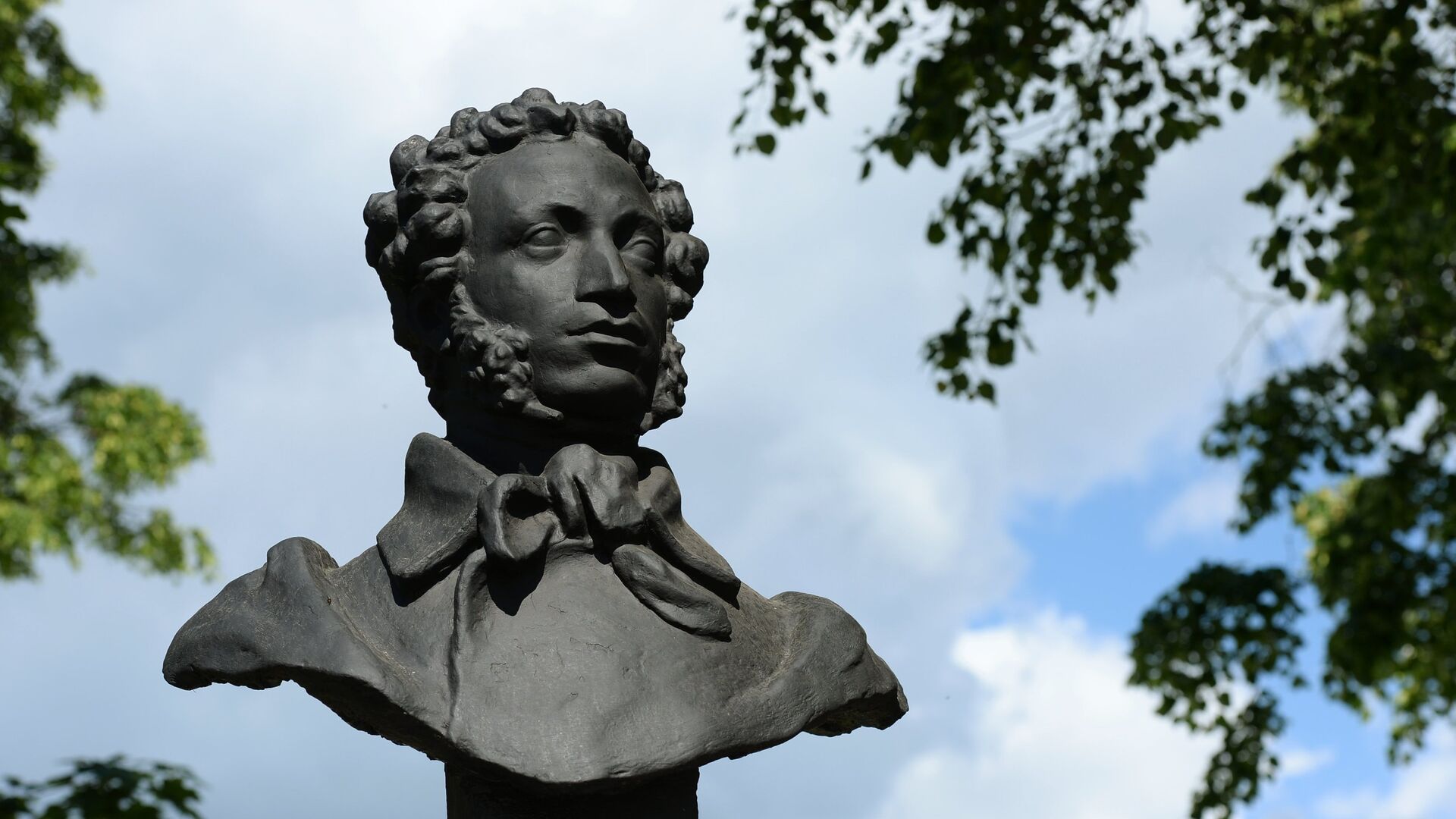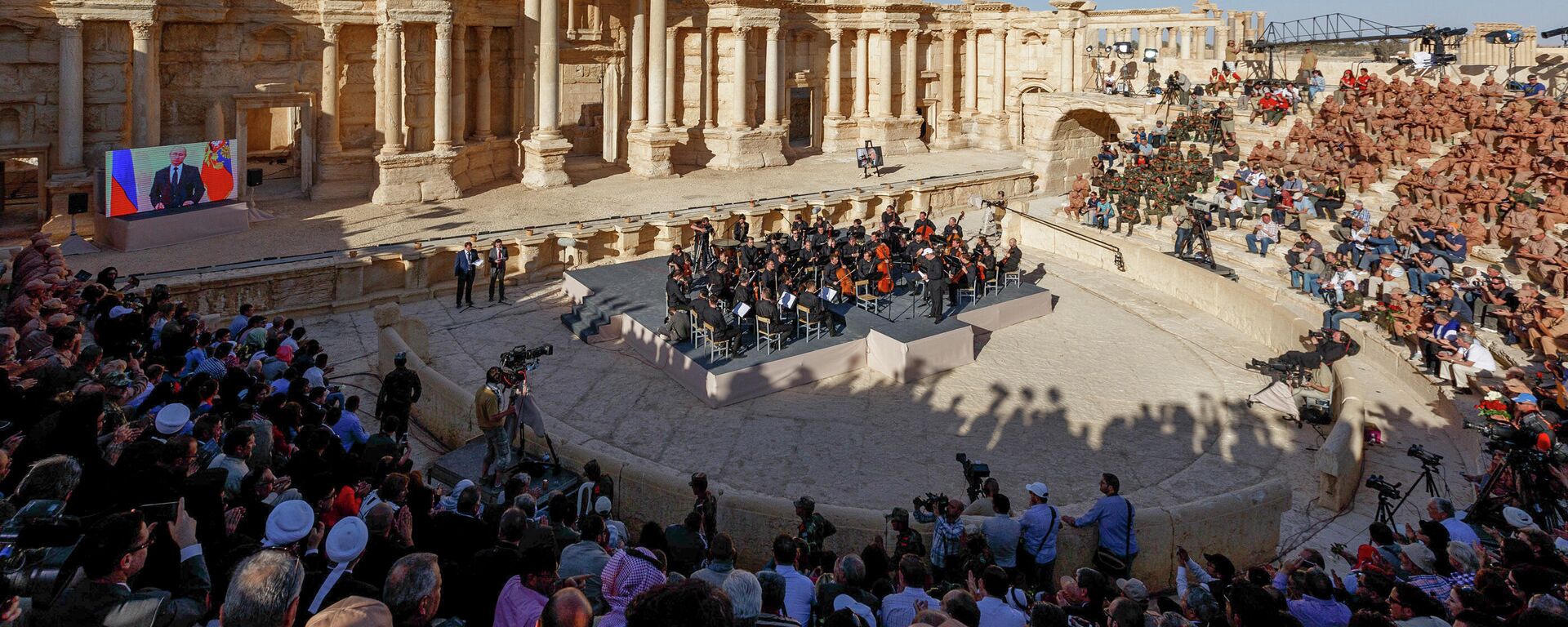https://sputnikglobe.com/20230218/how-west-creates-new-abnormality-poet-pushkin-is-french-war-is-peace-whats-next-1107568934.html
How West Creates 'New Abnormality:' Poet Pushkin is French? War is Peace? What's Next?
How West Creates 'New Abnormality:' Poet Pushkin is French? War is Peace? What's Next?
Sputnik International
The French Embassy in Central African Republic is trying to pass off the great Russian poet of African origins Alexander Pushkin as a Frenchman.
2023-02-18T09:43+0000
2023-02-18T09:43+0000
2023-02-18T09:43+0000
africa
central africa
central african republic
france
ukraine
culture
russia
art
metropolitan museum of art
russian culture
https://cdn1.img.sputnikglobe.com/img/102669/52/1026695260_0:0:3083:1734_1920x0_80_0_0_041dc7d20c862e97ee957e51191c0c9d.jpg
The French Embassy in the Central African Republic is now trying to pass off the great Russian poet of African origins Alexander Pushkin as a Frenchman, launching lectures on his works and legacy while presenting him as an "Afro-French figure."Spokeswoman for the Russian Foreign Ministry Maria Zakharova reacted to this attempt to change Pushkin's nationality by saying that France's efforts to present the Russian poet as French is a "new abnormality."Alexander Pushkin (1799-1837) was a Russian poet, playwright, and novelist born in Moscow into a distinguished family of the Russian nobility. He was keen on art and literature, and spoke French fluently, as almost every aristocratic Russian family of that time did.Through his mother, Pushkin has African roots. His great-grandfather, Abraham Hannibal, was a freed slave, who served the Russian Emperor Peter the Great, of whom he was the godson and faithful friend.The initiative of changing Pushkin's nationality is part of a series of attempts to cancel Russian culture, a movement that appears to have a political background. Russian or Ukrainian? Three high-profile renamings have recently taken place at the New York Metropolitan Museum of Art. First, Arkhip Kuindzhi, and then Ilya Repin and Ivan Aivazovsky, were called Ukrainian artists, although all three were born almost two centuries ago in the Russian Empire. Ivan Aivazovsky's (1817-1900) painting "Ship by Moonlight" was published on February 12 on the official website of the museum. The description indicated that the author was a Ukrainian who lived in the territory of the Russian Empire and gained fame "within the Empire and abroad, cultivating the patronage of Russian nobles." The marine painter was born in Feodosia, a town in the Crimea on the coast of the Black Sea. He was born into an Armenian family. The artist called himself an Armenian by origin and Russian at heart.Apart from Aivazovsky, the Metropolitan Museum changed the nationality of another outstanding artist - Illya Repin (1844-1930). The caption under his painting "Vsevolod Mikhailovich Garshin" states that the artist was born in Chuguev, Ukraine, in the years "when it was part of the Russian Empire." On February 10, it became known that the Metropolitan Museum of Art also presented Arkhyp Kuindzhi (1841-1910), born in Mariupol, as a Ukrainian artist. In the caption under the painting "Red Sunset," the museum removed the text that the artist is renowned and respected both in Russia and Ukraine, but added that the Kuindzhi Art Museum in Mariupol, Ukraine, "was destroyed in a Russian airstrike."The names of the paintings themselves have also undergone unprecedented changes. The painting of the French impressionist Edgar Degas "Russian Dancers" was renamed on the websites of two galleries. In March 2022, the London National Gallery called the painting "Ukrainian Dancers." After almost a year, the Metropolitan Museum in New York changed its name to "Dancers in Ukrainian Dress." British media reported that in London, the change occurred at the request of some Ukrainian social media users living in the UK. For a similar reason, the renaming happened in New York. In 1899, Degas created a series of compositions dedicated to Russian dancers. He was inspired by the performance of artists of the Imperial Russian Ballet in Paris.
https://sputnikglobe.com/20220307/why-canceling-cultural-figures-is-assault-on-free-speech--another-display-of-russophobia-1093645879.html
africa
central africa
central african republic
france
ukraine
russia
Sputnik International
feedback@sputniknews.com
+74956456601
MIA „Rossiya Segodnya“
2023
News
en_EN
Sputnik International
feedback@sputniknews.com
+74956456601
MIA „Rossiya Segodnya“
Sputnik International
feedback@sputniknews.com
+74956456601
MIA „Rossiya Segodnya“
central african republic, france, russia, culture, alexander pushkin, russian culture, russian artists
central african republic, france, russia, culture, alexander pushkin, russian culture, russian artists
How West Creates 'New Abnormality:' Poet Pushkin is French? War is Peace? What's Next?
Following the beginning of Russia's special military operation in Ukraine, western countries not only sanctioned the country's economy and political establishment but launched a "canceling" campaign against Russian culture. Great Russian artists were depicted as Ukrainians alongside "Russian dancers," and this phenomenon seems to gain momentum.
The French Embassy in the Central African Republic is now trying to pass off the great Russian poet of African origins Alexander Pushkin as a Frenchman, launching lectures on his works and legacy while presenting him as an "Afro-French figure."
Spokeswoman for the Russian Foreign Ministry Maria Zakharova reacted to this attempt to change Pushkin's nationality by saying that France's efforts to present the Russian poet as French is a "new abnormality."
"The French Embassy in Central African Republic launched a series of lectures on outstanding figures of French culture. The hero of France's first lecture on culture was... Pushkin. A diplomat from Paris introduced him as 'an Afro-French figure with Russian roots'," Zakharova said in her Telegram channel.
Alexander Pushkin (1799-1837) was a Russian poet, playwright, and novelist born in Moscow into a distinguished family of the Russian nobility. He was keen on art and literature, and spoke French fluently, as almost every aristocratic Russian family of that time did.
Through his mother, Pushkin has African roots. His great-grandfather, Abraham Hannibal, was a freed slave, who served the Russian Emperor Peter the Great, of whom he was the godson and faithful friend.
The initiative of changing Pushkin's nationality is part of a series of attempts to cancel Russian culture, a movement that appears to have a political background.
Three high-profile renamings have recently taken place at the New York Metropolitan Museum of Art.
First, Arkhip Kuindzhi, and then Ilya Repin and Ivan Aivazovsky, were called Ukrainian artists, although all three were born almost two centuries ago in the Russian Empire.
Ivan Aivazovsky's (1817-1900) painting "Ship by Moonlight" was published on February 12 on the official website of the museum. The description indicated that the author was a Ukrainian who lived in the territory of the Russian Empire and gained fame "within the Empire and abroad, cultivating the patronage of Russian nobles." The marine painter was born in Feodosia, a town in the Crimea on the coast of the Black Sea. He was born into an Armenian family. The artist called himself an Armenian by origin and Russian at heart.
Apart from Aivazovsky, the Metropolitan Museum changed the nationality of another outstanding artist - Illya Repin (1844-1930). The caption under his painting "Vsevolod Mikhailovich Garshin" states that the artist was born in Chuguev, Ukraine, in the years "when it was part of the Russian Empire."
On February 10, it became known that the Metropolitan Museum of Art also presented Arkhyp Kuindzhi (1841-1910), born in Mariupol, as a Ukrainian artist. In the caption under the painting "Red Sunset," the museum removed the text that the artist
is renowned and respected both in Russia and Ukraine, but added that the Kuindzhi Art Museum in Mariupol, Ukraine, "was destroyed in a Russian airstrike."
The names of the paintings themselves have also undergone unprecedented changes. The painting of the French impressionist Edgar Degas "Russian Dancers" was renamed on the websites of two galleries. In March 2022, the London National Gallery called the painting "Ukrainian Dancers." After almost a year, the Metropolitan Museum in New York changed its name to "Dancers in Ukrainian Dress."
British media reported that in London, the change occurred at the request of some Ukrainian social media users living in the UK. For a similar reason, the renaming happened in New York. In 1899, Degas created a series of compositions dedicated to Russian dancers. He was inspired by the performance of artists of the
Imperial Russian Ballet in Paris.



